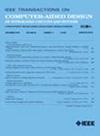HALTRAV: Design of a High-Performance and Area-Efficient Latch With Triple-Node-Upset Recovery and Algorithm-Based Verifications
IF 2.7
3区 计算机科学
Q2 COMPUTER SCIENCE, HARDWARE & ARCHITECTURE
IEEE Transactions on Computer-Aided Design of Integrated Circuits and Systems
Pub Date : 2024-12-04
DOI:10.1109/TCAD.2024.3511335
引用次数: 0
Abstract
With the rapid advancement of semiconductor technologies, latches become increasingly sensitive to soft errors, especially triple node upsets (TNUs), in harsh radiation environments. In this article, we first propose a high-performance and area-efficient latch, namely, HALTRAV, featuring complete TNU-recovery. The storage portion of HALTRAV consists of 28 interlocked source-drain cross-coupled inverters (SCIs) for complete TNU-recovery with area efficiency and low delay. To mitigate the issue that node-upset-recovery verifications for existing latches highly relies on electronic design automation tools, we further propose an algorithm-based verification method that can automatically verify the node-upset-recovery of latches, which greatly simplifies the reliability-verification flow. Simulation results demonstrate the TNU-recovery of HALTRAV and also show that HALTRAV achieves 40.38%, 8.17%, and 31.89% reduction in delay, area, and delay-power–area product (DPAP) on average, respectively; however; it is at the cost of power as compared to typical latches that are TNU-recoverable. Comparison results also demonstrate the moderate sensitivity of HALTRAV to the impacts of the process, voltage, and temperature (PVT) variations.HALTRAV:一种高性能和区域高效锁存器的设计,具有三节点破坏恢复和基于算法的验证
随着半导体技术的快速发展,锁存器在恶劣的辐射环境中对软误差,特别是三节点扰动(tnu)越来越敏感。在本文中,我们首先提出了一种高性能和面积高效的锁存器,即HALTRAV,具有完全的tnu恢复功能。HALTRAV的存储部分由28个互锁源漏交叉耦合逆变器(sci)组成,具有面积效率和低延迟,可实现完全的tnu恢复。为了解决现有锁存器节点故障恢复验证高度依赖电子设计自动化工具的问题,我们进一步提出了一种基于算法的锁存器节点故障恢复自动验证方法,大大简化了可靠性验证流程。仿真结果证明了HALTRAV的tnu恢复能力,并表明HALTRAV的延迟、面积和延迟-功率-面积积(DPAP)平均分别降低了40.38%、8.17%和31.89%;然而;与典型的tnu可恢复锁存器相比,这是以电力为代价的。对比结果还表明,HALTRAV对工艺、电压和温度(PVT)变化的影响具有中等灵敏度。
本文章由计算机程序翻译,如有差异,请以英文原文为准。
求助全文
约1分钟内获得全文
求助全文
来源期刊
CiteScore
5.60
自引率
13.80%
发文量
500
审稿时长
7 months
期刊介绍:
The purpose of this Transactions is to publish papers of interest to individuals in the area of computer-aided design of integrated circuits and systems composed of analog, digital, mixed-signal, optical, or microwave components. The aids include methods, models, algorithms, and man-machine interfaces for system-level, physical and logical design including: planning, synthesis, partitioning, modeling, simulation, layout, verification, testing, hardware-software co-design and documentation of integrated circuit and system designs of all complexities. Design tools and techniques for evaluating and designing integrated circuits and systems for metrics such as performance, power, reliability, testability, and security are a focus.

 求助内容:
求助内容: 应助结果提醒方式:
应助结果提醒方式:


